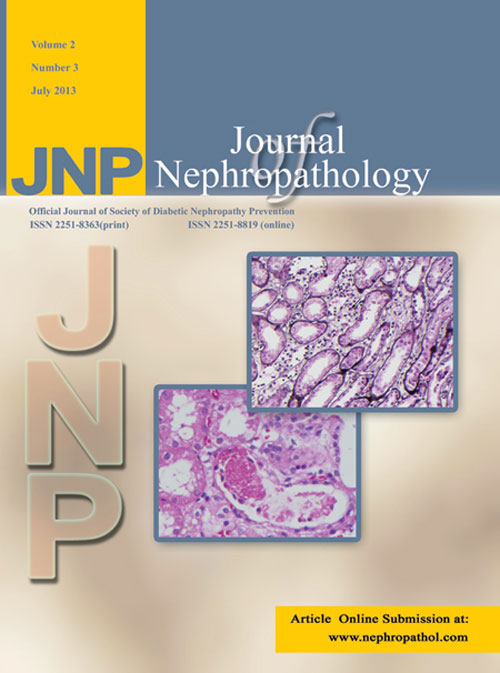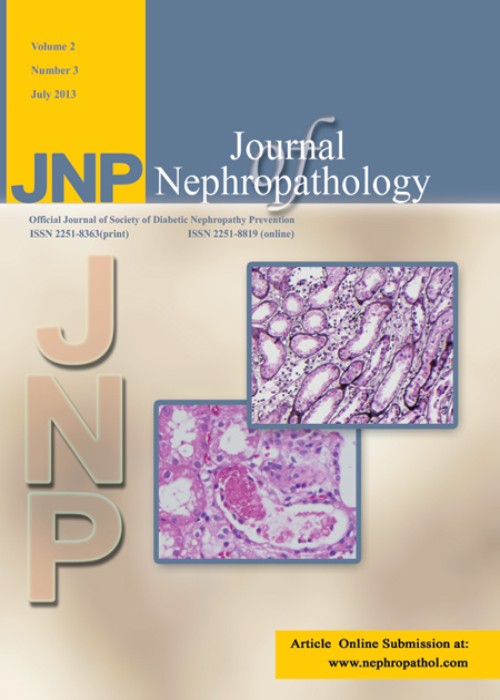فهرست مطالب

Journal of nephropathology
Volume:9 Issue: 4, Oct 2020
- تاریخ انتشار: 1399/03/26
- تعداد عناوین: 11
-
Page 2
Coronaviruses are a large family of viruses that can cause a variety of diseases in humans. Some coronaviruses cause only mild illnesses like the common cold. While, some coronaviruses such as SARS-CoV (SARS-associated coronavirus) and Middle East respiratory syndrome coronavirus (MERS-CoV) have, in recent years, been able to cause severe respiratory involvement (pneumonia), leading to death in several patients. By identifying the genomic sequence of the new human coronavirus SARS-CoV-2 (severe acute respiratory syndrome coronavirus 2) it has been revealed that it belongs to the beta coronavirus genus. COVID-19 appears to be transmitted by a mechanism similar to the influenza virus via person to person, sneezing coughing, or contact with the secretions of infected patients. Early symptoms of these respiratory viruses include fever, cough, and shortness of breath, with an incubation period of 2-14 days. SARS-CoV-2 is an acute respiratory disease that initially causes lung damage. SARS-CoV-2 can affect other organs, including the kidneys. Kidney damage may be caused by alterations that occur during coronavirus infection. It seems that low-oxygen delivery to tissues like the kidney in the setting of this disease may lead to ischemic damage of the kidney. Considering the importance of the kidneys, as one, this review study aimed to investigate the effect of the new coronavirus on the kidneys and its role in the development of renal failure.
Keywords: Acute kidney injury, Infection, Coronavirus, COVID-19, Severe acute respiratorysyndrome coronavirus 2 -
Page 3
The severe acute respiratory syndrome (SARS) is an infectious disease developed in Wuhan, China, at first. It involves the respiratory system and other organs like kidney, gastrointestinal tract and nervous system as well. The recent reports indicated that renal disorder is prevalent in coronavirus patients. The aim of this study was to provide a review of nephropathy caused by severe acute respiratory syndrome-coronavirus-2 (SARS-CoV-2) and its mechanisms. The Web of Science, Scopus, and PubMed databases were systematically searched. Articles reporting nephropathy, coronavirus disease (COVID-19), coronavirus and the renal injury were included for assessment. Study designs, contrast agents, case reports and results were assessed. Of the assessed studies, suggested mechanisms include sepsis which caused cytokine storm syndrome or perhaps direct cellular injury due to the virus. In patients who were studied, albuminuria, proteinuria, and hematuria as well as an elevation in blood urea nitrogen and serum creatinine were observed. Additionally CT scan of the kidneys showed a decrease in tissue density suggestive of inflammation and interstitial edema. On the other hand, dialysis patients are a high-risk group than the general population. The current treatment for COVID-19 in acute kidney injury includes supportive management or kidney replacement therapy. All patients need to be quarantined. An N95 fit-tested mask and protective clothing and proper equipment are necessary. Some drugs can be effective to inhibit the outcome of this infection such as lopinavir/ritonavir, remdesvir, Chloroquine phosphate, convalescent plasma, tocilizumab, ACEi/ ARBs (angiotensin-converting enzyme inhibitor/angiotensin receptor blockers), and hrsACE2 (human recombinant soluble angiotensin-converting-enzyme 2).
Keywords: Coronavirus, COVID-19, Nephropathy, Kidney, Angiotensin converting enzyme -
Page 4
Fabry disease is an X-linked disorder due to mutations in alpha-galactosidase A gene. It affects the kidney in virtually all patients with classical and some late onset variants. Podocytes, endothelial cells, vascular smooth muscle, tubular and mesangial cells are involved in different ways. Proteinuria and chronic kidney disease are the result of the progressive accumulation of the enzyme substrates globotriaosylceramide (GB3) and lyso-GB3 in the cytoplasm of these cells (mainly in lysosomes), which leads to cellular and organ dysfunction and eventually renal failure and end-stage kidney disease. Specific enzyme replacement therapy and pharmacological chaperone are at present the main therapeutic approach. After enzyme infusion, the delivered enzyme is differentially uptaken by kidney cells in three different ways: By Mannose-6-phosphate receptor, megalin and sortilin. The delivered enzyme gradually clears cells from the accumulation of the glycosphingolipids and contributes to a cellular healthier status. The recent pandemic caused by SARS-CoV-2 has led to the collapse of health systems around the world and to thousands of deaths. Kidney involvement has been reported to range from proteinuria to acute kidney injury, 30% of which may require renal replacement therapy. In this review the potential causes for which Fabry patients should be at increased risk and the necessity not to discontinue therapy are discussed.
Keywords: Fabry nephropathy, SARS-CoV-2, Podocyte, Endothelium, Proteinuria, Angiotensin-converting enzyme-2 -
Page 5
Statins, as the most important cholesterol-lowering agents, inhibit the production of blood cholesterol by blocking an enzyme called the 3-hydroxy-3-methylglutaryl coenzyme A (HMG-COA) reductase. Statins have beneficial effects in some tissues during various injuries. Recent evidence suggests that unlike the beneficial effects of statins, administration of high doses of these drugs may increase renal impairment, although more research is needed in this regard. Therefore, this study aimed to evaluate the possible effect of different doses of statins on the morphology and function of the kidney tubular cells.
Keywords: Statin, HMG-COA reductase, Renaltoxicity -
Page 6Implication for health policy/practice/research/medical education
The pathogenetic mechanism of renal involvement in coronavirus disease 19 (COVID-19) is still unclear. It is supposed to result from a combination of several contributing factors, such as state of dehydration, leading to pre-renal failure with acute tubular necrosis, toxic tubular damage, induced by cytokine storm or rhabdomyolysis, cytopathic action induced by the virus that invades ACE2- expressing kidney cells and drug-induced nephrotoxicity
Keywords: COVID-19 nephropathy, SARS-relatedcoronavirus, Severe acute respiratorysyndrome -
Page 7Implication for health policy/practice/research/medical education
In December 2019, an outbreak of coronavirus disease (COVID-19) due to the novel SARS-CoV-2 (severe acute respiratory syndrome coronavirus 2) virus began in China and spread rapidly worldwide. After China, Italy is the country with the highest number of cases so far. There are only limited data on COVID-19 in patients affected by chronic kidney disease. Herein, we report the outcomes of two patients with COVID-19 pneumonia who required renal replacement therapy. It is unknown whether hemodialysis patients represent a distinct group of patients with certain characteristics that may make them susceptible to infection or severe disease. In this letter, we describe our clinical experience with COVID-19 patients.
Keywords: COVID-19, Acute kidney injury, Dialysis, Severe acute respiratorysyndrome coronavirus 2, Acutetubular injury, End-stage renaldisease, Coronavirus disease -
Page 8Implication for health policy/practice/research/medical education
The mechanistic understanding of signaling pathways that contributes to the kidney involvement by coronavirus disease 2019 (COVID-19) is an extremely critical point for improving therapeutic options. These pathways consist of the production of pro-inflammatory factors, the infiltration of pro-inflammatory cells into the renal interstitium, the activation of C5b-9 complexes, and receptorangiotensin converting enzyme 2 (ACE2). Cytopathogenic effects and invasion into renal tubular cells have been confirmed.
Keywords: COVID-19 nephropathy, Coronavirus, Acute kidney injury, C5b-9 complexes, Interstitum -
Page 9Introduction
The concept of diabetic nephropathy, as a metabolic disease, is now being replaced by chronic low-grade inflammatory disease. Tumor necrosis factor alpha (TNF-α) is a proinflammatory cytokine that plays an important role in the pathogenesis and clinical outcomes of diabetic nephropathy.
ObjectivesThis study aimed to determine the relationship between plasma and urinary levels of TNF-α and chronic kidney disease (CKD) in patients with type 2 diabetes mellitus. Patients and
MethodsIn this descriptive-analytical study, patients with type 2 diabetes mellitus who referred to the endocrine clinic in Kashan (2016) were enrolled in the study and their clinical and laboratory data were recorded. Albumin/creatinine ratio (ACR) and glomerular filtration rate (GFR) were calculated. The patients were divided into three groups based on their GFR. Serum and urinary levels of TNF-α were determined by ELISA and were compared between the studied groups.
ResultsA total of 128 patients were evaluated. Of all, 35 patients (27.3%), 39 patients (30.4%), and 54 patients (42.3%), respectively, were suffering from stage 1, stage 2, and stage 3 CKD. The plasma levels of TNF-α in patients with stage 1, 2, and 3 CKD, were 66.20 ± 33.27 pg/mL, 67.47 ± 42.98 pg/mL, and 77.32 ± 47.23 pg/mL respectively, since the difference among them was not significant (P= 0.417). In addition, the urinary levels of TNF-α in patients with stage 1, 2, and 3 CKD, respectively, were 88.18 ± 26.66 pg/mL, 97.41 ± 57.76 pg/mL, and 101.18 ± 60.47 pg/mL, since no significant difference was observed between the three groups (P=0.957).
ConclusionBased on the results of this study, with changing the stage of CKD, the serum and urinary levels of the TNF-α increases too, although this increase is not significant. Moreover, the plasma and urinary levels of the TNF-α have a direct and significant relationship with each other. It is recommended to conduct further studies in this field.
Keywords: Type II diabetes mellitus, Chronic kidney disease, Diabetic nephropathy, Tumor necrosis factor, End-stage renal disease, Angiotensin aldosterone system -
Page 10Introduction
Kidney stones are glycoproteins sediments that are formed inside kidney tubules and collecting ducts and are made of acid crystals and minerals.
ObjectivesThis study aimed to compare the effects of Peganum harmala seed and tamsulosin on pain relief and expulsion of renal and ureteral stones in patients candidate for medical therapy. Patients and
Methodsin this randomized clinical trial 80 patients older than 18 years with kidney and ureteral stones sized 4 to 10 mm were randomly allocated to one of two groups by simple sampling method. In group one, after performing ultrasonography and confirming the presence of 4 to 10 mm stone one capsule of tamsulosin 0.4 mg was prescribed per night for two weeks. In group two, harmala seed preparing in form of capsule with dose of 50 mg/kg/d, was prescribed after meal as the same of first group. Two weeks later patients were re-visited and urinary tract ultrasonography was conducted and the change in size of stones and presence of residual stones evaluated and recorded. The severity of pain in the patients was checked using VAS (visual analogue scale). Then the data was collected and analyzed at the end of the study.
ResultsMean size of stones after treatment were 4.07±3.66 and 5.15 ± 3.63 mm respectively (P= 0.21). Mean numbers of stones before and after treatment were 0.59±1.38 and 1.18±0.94 (P=0.052). Pain score decreased significantly in both groups which was more significant in P. harmala group (P=0.002). Efficacy of treatment (sum of complete and partial response) in the two groups was 77.5 % and 77.8 % respectively and no significant differences between the two groups were seen (P=0.06). There was no significant side effect in the two groups.
ConclusionThis study showed that both P. harmala seed and tamsulosin decrease urinary stone size and numbers without significant difference, but pain score decreased significantly by P. harmala.
Keywords: Peganum harmala, Tamsulosin, Treatment, Urinary stones -
Page 11Introduction
Diabetes, hypertension and obesity are associated with endothelial dysfunction. The first sign of endothelial dysfunction is microalbuminuria.
ObjectivesThe aim of this study was to measure urine albumin to creatinine ratio in obese patients without diabetes and with normal blood pressure. Patients and
MethodsIn this cross-sectional study, 200 adults were chosen with body mass index (BMI) ≥25 kg/m2 . Anthropometry measurements [BMI and waist to hip ratio (WHR)] and biochemical tests were performed. Data were analyzed using chi-square test, analysis of variance (ANOVA), and Pearson’s correlation coefficient.
ResultsAmong 200 obese people, microalbuminuria was seen in 22 individuals (11%). The prevalence of microalbuminuria was positively increased with increasing of BMI (P= 0.04). Moreover, microalbuminuria was significantly higher in people with WHR >1 (P=0.02).
ConclusionThrough this study, we detected the association of microalbuminuria with BMI and WHR. Therefore, efforts must be conducted to reduce obesity through lifestyle changes and regular exercise.
Keywords: Obesity, Albuminuria, Body mass index, Waist to hip ratio, Endothelial dysfunction, Obesity-related glomerulopathy, Chronic kidney disease, Focal segmental glomerulosclerosis


